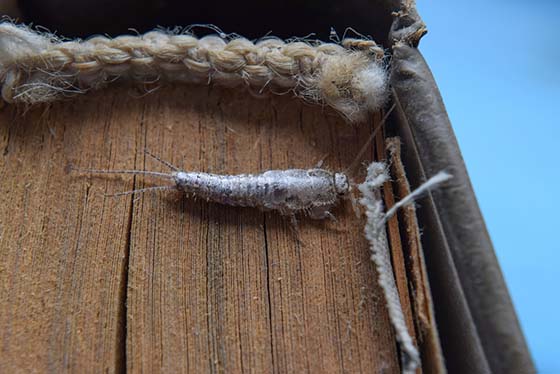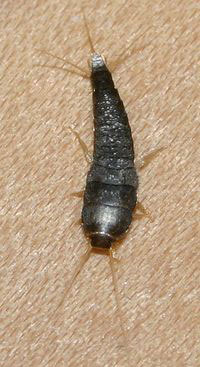Silverfish: The Ultimate Guide
You may have never heard of silverfish before, but after you see one, it may be hard to forget. Silverfish bugs are the epitome of creepy bugs with their distinctive appearance and alarming movements. While silverfish are not dangerous, you definitely do not want them in your home. If you have questions about silverfish, we have the answers. Learn how to identify, prevent, and control these household pests.
What do silverfish look like?
Silverfish (lepisma saccharina) are known for their fish-like looks and movements, but they are definitely not fish. Silverfish are small, wingless insects that are tear-drop shaped. As the name suggests, these insects are normally bluish-silver in color but can also be white or brownish-grey. Silverfish average 13-19 mm in length. They have 6 legs and 2 long antennae. Their elongated body tapers to a narrow rear end where 3 long bristles (cerci) protrude. If the physical description isn’t enough for you to confirm their identity, their movements may seal the deal. Silverfish move in a wiggling motion that makes them appear to be swimming. Despite this strange movement, silverfish are fast and agile runners.
Silverfish bug are also sometimes referred to as “bristletails” because of the appendages that protrude from the end of their abdomen. The term bristletail can also apply to firebrats (thermobia domestica). Firebrats are very similar to silverfish with a few key differences
Silverfish undergo gradual metamorphosis, meaning that the immature stages look very similar to adults, but they lack the ability to reproduce. A female silverfish will typically lay about 100 eggs in her lifetime. These eggs are very small, white, and oval-shaped, and are typically laid in small cracks or crevices or under stones or leaf litter.
Where do silverfish live?
Silverfish are found throughout the world in Africa, the Americas, Australia, Eurasia, and the Pacific. They live in dark, warm, humid environments. They prefer a relative humidity of 70%-90% and a temperature from 70-85 degrees. When they enter homes, they seek out environments that meet these criteria like attics, kitchens, bathtubs or showers, and under sinks

How To Get Rid of Silverfish
Looking to get rid of Silverfish, well you came to the right place!
In this guide on how to get rid of silverfish, you’ll learn:
How to prevent silverfish in the first place
How to identify clothes silverfish
The do’s and don’ts of silverfish removal (not to be skipped)
And some frequently asked silverfish removal questions
If you’re wondering, What are silverfish and should I care, well then you’ve been lucky enough not to have them in your home, destroying your books, photo albums, important documents or contaminating your dry food supply.
Silverfish can be slow to multiply but they are also hard to deal with and can cause quite a bit of damage in the meantime. They should not be taken lightly if you see them around your home. From natural remedies to silverfish sprays, to hiring an exterminator or even good house hygiene, there are many ways to prevent and remove them, but what actually works?
Can Silverfish be beaten?
To introduce this guide, I wanted to write some information on the question we get asked the most and provide some comfort in the fact that yes these silverfish can be beaten. Knowing there are silverfish in your home, laying eggs and damaging your home can cause anxiety, sleepless nights and stress. Silverfish are very slow breeders but live longer than you may think. An average silverfish can live for up to 8 years and in that period lay up to 100 eggs.
Four of the Biggest Reasons For Silverfish Infestations are
Lack of preventive measures in your home
Bad advice on the internet
Incomplete DIY extermination practices
Incompetent exterminators
Despite the difficulty to remove silverfish yourself, there are proven ways to remove silverfish infestations without an exterminator. At certain infestation levels, you will need to call a professional, and we’ll cover later in this guide when you should think about calling one before it is too late.
What do silverfish look like?
So, what are silverfish and what do they look like? Silverfish are some of the oldest living insects on the planet. Evolutionary they appeared before insects developed wings and are therefore considered primitive insects. They look very much like something you would expect to see in prehistoric times.

How to Get Rid of Silverfish
If you have found silverfish or signs of silverfish in your home, you can get rid of them with the proper products and treatments. Read our guide below to learn more about silverfish treatment and how to get rid of silverfish yourself.
Use Professional Grade Products
There are three types of products we recommend using to combat a silverfish infestation: silverfish packs, perimeter bait, and insecticide. By using all three products in conjunction with one another, you will have the most success controlling your infestation.
Silverfish packs are an easy and economical way to kill silverfish. Simply place the packs in infested areas and wait. The silverfish will eat through the packs and ingest the poison inside. Place packs in closets, bookcases, attics, basements, storage areas, and anywhere you have seen silverfish.
Treat With Perimeter Bait
Using a granular insecticide perimeter bait, like InTice 10, in addition to silverfish packs will also aid in eliminating silverfish. Apply the perimeter bait in attics near eaves and vent pipes, in the corners of basements, in crawl spaces, and in drop ceilings. Use a shaker or duster to apply bait around the perimeter of attics and basements. Do not apply where children or pets have access.
A liquid insecticide treatment will kill the silverfish living in your home. Treating the inside of your home in addition to using silverfish packs and perimeter bait will control your silverfish infestation. To treat the inside of your home, mix an insecticide labeled for silverfish, such as Bifen IT, according to the product label. Use 1 ounce of Bifen IT per gallon of water (or the ratio of product to water indicated on the label of your chosen insecticide), and mix in a hand pump sprayer. Wear protective gloves and long-sleeves when working with insecticide.
Silverfish
Are you sick and tired of seeing those slimy, disgusting, filthy little silver bugs scurrying up the walls in your bathroom, your kitchen, or .. even worse.. your bedroom? Have you ever tried to get rid of them? Not that easy, is it!
Sure.. squishing them might make you feel like you’re making a difference, but it just doesn’t solve the problem. They’ll keep coming back again and again and again. So take the next 5 minutes to read over this page and you will learn exactly what you need to know to get rid of silverfish.
The fact that you’ve arrived at this website should be evidence enough that you want to get rid of your silverfish infestation. But like most people, you may not think silverfish are anything more than a “nuisance pest.”
But the more you find out about silverfish, the more you will start to realize that not taking action against them is a very poor decision. They are much more harmful and intrusive than you may think.
Here are six facts about silverfish that you may have been happier not knowing:
x Silverfish damage your home – Silverfish like to feed on the glue behind your wallpaper. If you let it go on for too long they can cause costly damage that will significantly lower the value of your home or cost you hundreds (if not thousands) of dollars in repairs.
x Silverfish are most active at night – That means they can be crawling on you when you sleep! (So gross!) It happened to me once when I was reading in bed one night. It was the final straw and I knew I had to take action against them!
x Silverfish eat your cereal – This is probably something you could have lived more comfortably without knowing.. These disgusting bugs can get into your cereal boxes and eat your cereal.
x Silverfish eat your plants – If you keep plants in your home they can cause damage to them too! Plant material is a common food source for silverfish.
x Silverfish eat your clothes – Silverfish are also attracted to eating silk, synthetic fabrics and cotton clothing, so they may be crawling around in your clothes when you hang them in the closet. You won’t be too happy when you put on shirt that has silverfish in it.
x Silverfish are just plain embarrassing – Ever have company over for dinner? Do you feel shy and ashamed to let guests use your bathroom because you know they’re going to see silverfish crawling on the walls and around the side of your toilet?
Silverfish
Appearance
Silverfish are small, wingless insects usually measuring 20mm or less in length. They have three tails (or cerci) and their body is covered in tiny silver scales.
Habits
Silverfish do not have wings but are able to run very fast. They are usually seen in moist, humid areas in the home, such as bathrooms, basements, and attics.
They feed off molds and starchy materials like cereals, flour, sweet foods, paper, curtains and wallpaper items. Silverfish can live up to a year without food, but require an environment of high humidity. They move fast and are by nature nocturnal.
Threats
While silverfish are mainly a nuisance pest, because they can contaminate food and damage paper goods such as wallpaper and books.
Long-term Silverfish Prevention – Control Humidity
One option is to install a dehumidifier in your home.
Other options are to identify and repair leaky pipes and drains and also
Eliminate or repair any mouldy/wet wood or walls.
Improve ventilation in bathroom (e.g. bigger fan)
Fit an electric fan heater to raise temperature and evaporate condensation in shower room
Do not use a clothe horse indoors. Rather use a condenser dryer (“A” rated dryers cost less than 30c in electricity per cycle).